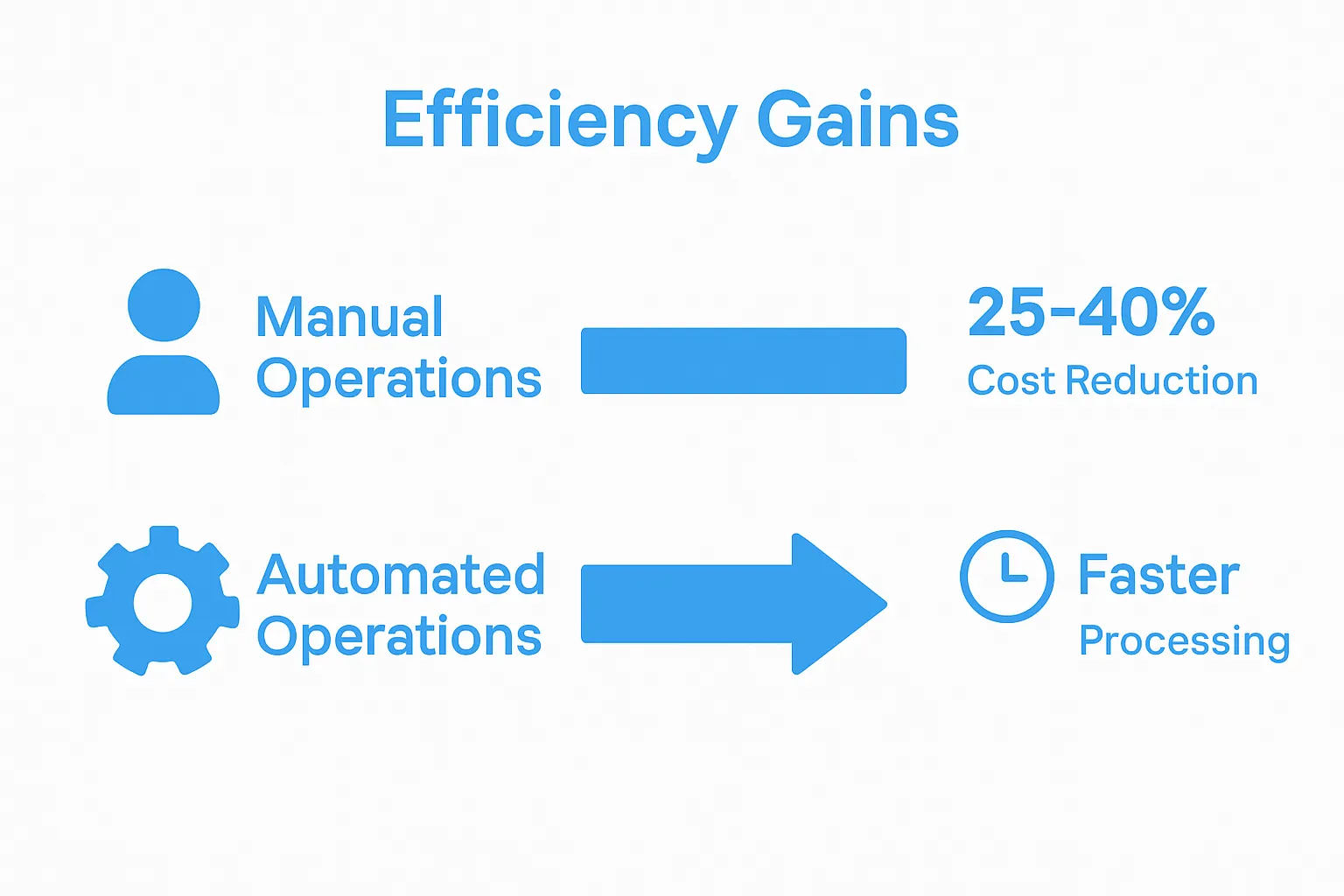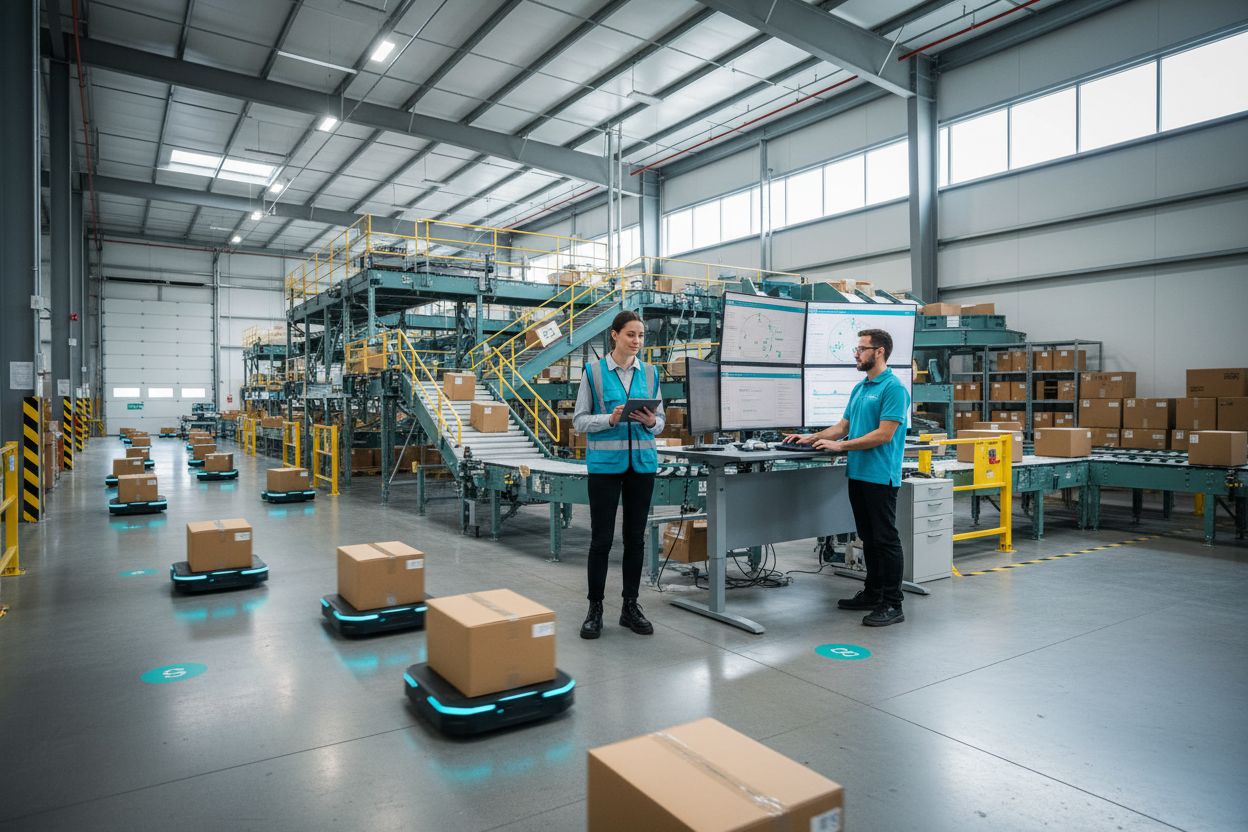Ecommerce businesses are changing faster than ever with technology doing more behind the scenes every day and letting people focus on what really matters in the shop. Most folks think automation is just about saving time or cutting out boring admin work. But here’s the kicker. Companies using automation cut operational costs by up to 30 percent and that is only the tip of the iceberg. What matters most is how it gives customers a personalised experience and helps businesses make smart decisions on the fly.
Table of Contents
- What Is Automation In Ecommerce And Why It Matters?
- The Role Of Technology In Ecommerce Automation
- Key Benefits Of Implementing Ecommerce Automation
- Understanding The Different Types Of Ecommerce Automation
- Real-World Examples Of Successful Ecommerce Automation
Quick Summary
| Takeaway | Explanation |
|---|---|
| Ecommerce automation streamlines operations. | Automation uses technology to perform repetitive tasks, enhancing efficiency and allowing businesses to focus on growth. |
| Cost savings of 25-40% possible. | Businesses can significantly reduce operational costs while improving productivity through effective automation strategies. |
| Enhanced personalized customer experiences. | Automation enables tailored communications and proactive engagement, improving customer satisfaction and loyalty. |
| Integrate advanced technologies for success. | Using AI, machine learning, and cloud solutions enhances automation capabilities, creating dynamic, responsive systems. |
| Case studies showcase real-world benefits. | Companies like Amazon and Zara successfully apply automation to optimize their operations and customer interactions. |
What is Automation in Ecommerce and Why It Matters?
Automation in ecommerce represents a strategic approach to streamlining digital business processes using technology that reduces manual intervention and enhances operational efficiency. At its core, this concept transforms how online businesses manage complex workflows, customer interactions, and backend operations.
Understanding Ecommerce Automation Fundamentals
Ecommerce automation involves using software tools and integrated systems to execute repetitive tasks automatically, allowing businesses to focus on growth and strategic decision making. Learn more about digital transformation strategies that complement these technological advancements.
Key areas where automation significantly impacts ecommerce include:
- Order Processing: Automatically managing inventory, generating invoices, and tracking shipments
- Customer Communication: Sending personalised emails, order confirmations, and follow-up messages
- Marketing Workflows: Triggering targeted campaigns based on customer behaviour and purchase history
The Strategic Value of Automation
Businesses implementing ecommerce automation can expect substantial benefits. According to McKinsey Digital, companies that effectively leverage automation can reduce operational costs by up to 30% while improving customer satisfaction and retention rates.
The real power of automation lies not just in efficiency, but in creating personalised, responsive experiences that meet modern consumer expectations. By reducing human error, accelerating processes, and enabling data-driven decisions, automation transforms ecommerce from a transactional model to an intelligent, adaptive ecosystem.
The Role of Technology in Ecommerce Automation
Technology serves as the fundamental infrastructure enabling sophisticated ecommerce automation, transforming digital business operations through intelligent systems and advanced software solutions. Learn more about essential ecommerce website elements that support technological integration.
Core Technological Foundations
Modern ecommerce automation relies on interconnected technological platforms that communicate seamlessly across multiple business functions. These systems leverage artificial intelligence, machine learning algorithms, and robust cloud computing infrastructures to create dynamic, responsive digital environments.
Key technological components driving ecommerce automation include:
- Integration Platforms: Connecting disparate software systems and enabling real-time data exchange
- Cloud-Based Solutions: Providing scalable infrastructure for handling complex computational tasks
- API Connectivity: Facilitating smooth communication between different software applications
Emerging Technologies Shaping Automation
According to Gartner Research, emerging technologies are rapidly expanding the capabilities of ecommerce automation. Advanced technologies such as robotic process automation (RPA), predictive analytics, and intelligent workflow management are creating unprecedented opportunities for businesses to optimise their digital operations.
These technological innovations enable businesses to move beyond traditional transactional models, creating intelligent systems that can predict customer behaviour, automate complex decision making, and deliver personalised experiences at scale. By integrating sophisticated technological solutions, ecommerce platforms can transform raw data into strategic insights, driving efficiency and competitive advantage in an increasingly digital marketplace.
Key Benefits of Implementing Ecommerce Automation
Ecommerce automation delivers transformative advantages that extend far beyond simple operational efficiency. Explore our comprehensive guide to personalization strategies to understand how automation enhances customer experiences.
Operational Efficiency and Cost Reduction
Implementing automation dramatically reduces manual labour and administrative overhead. Businesses can reallocate human resources from repetitive tasks to strategic initiatives, creating more value and driving innovation. According to Deloitte Digital, companies utilizing advanced automation can reduce operational costs by 25-40% while significantly improving productivity.

Key operational benefits include:
- Reduced Human Error: Minimising mistakes in order processing and inventory management
- Faster Processing Times: Accelerating workflows and reducing administrative bottlenecks
- Resource Optimization: Enabling staff to focus on high-value strategic tasks
Enhanced Customer Experience
Automation enables unprecedented levels of personalization and responsive customer engagement. By leveraging data-driven insights and intelligent systems, businesses can create tailored interactions that feel immediate and relevant to each customer.
Strategic automation allows businesses to implement sophisticated customer journey mapping, predictive support mechanisms, and intelligent communication strategies that anticipate and address customer needs before they arise. This proactive approach transforms traditional transactional relationships into dynamic, responsive customer experiences that build long-term loyalty and trust.
Understanding the Different Types of Ecommerce Automation
Ecommerce automation encompasses multiple strategic approaches designed to streamline business processes and enhance digital performance. According to CIO Magazine, automation strategies can be categorised into distinct operational domains that address specific business needs.
Marketing and Customer Engagement Automation
Marketing automation represents a sophisticated approach to generating personalised customer experiences through intelligent digital interactions. These systems leverage data analytics and machine learning to create targeted communication strategies that adapt in real time.
Key marketing automation techniques include:
- Email Campaign Sequencing: Triggering contextual email communications based on customer behaviour
- Segmentation Strategies: Dynamically categorising customers for precision targeting
- Recommendation Engines: Generating personalised product suggestions
Operational and Backend Automation
Operational automation focuses on streamlining backend processes that support seamless ecommerce functionality. These systems automate complex workflows related to inventory management, order processing, and logistical coordination.
Critical operational automation functions encompass:
- Inventory Synchronisation: Real-time tracking and updating of stock levels across multiple sales channels
- Shipping and Fulfillment: Automated label generation and carrier selection
- Financial Reconciliation: Automated invoicing and payment tracking processes
By implementing comprehensive automation strategies across marketing and operational domains, businesses can create more responsive, efficient digital ecosystems that adapt dynamically to changing market demands and customer expectations.
To help clarify the roles of different types of ecommerce automation discussed, the following table categorises and summarises the main approaches and their core functions.
| Automation Type | Primary Focus | Key Functions |
|---|---|---|
| Marketing & Customer Engagement | Personalised communication and customer journeys | Email sequencing, dynamic segmentation, product recommendations |
| Operational & Backend | Process efficiency and order management | Inventory synchronisation, shipping & fulfilment, invoicing |
Real-World Examples of Successful Ecommerce Automation
Successful ecommerce automation demonstrates the transformative potential of intelligent technological solutions across diverse business contexts. Explore effective digital marketing strategies to complement your automation approach.
Customer Journey Automation Case Studies
Leading companies have dramatically improved their operational efficiency and customer experience through strategic automation implementations. According to Harvard Business Review, businesses that effectively integrate automation can increase customer satisfaction rates by up to 25%.
Notable examples of successful automation include:
- Amazon: Utilizing predictive algorithms for personalised product recommendations
- Spotify: Dynamic playlist generation based on listening behaviour
- Netflix: Intelligent content suggestion systems that adapt to user preferences
Inventory and Supply Chain Automation
Advanced ecommerce platforms are leveraging automation to create more responsive and efficient supply chain management systems. These intelligent solutions enable real-time inventory tracking, automated reordering processes, and sophisticated demand forecasting.
Key implementations showcase how automation transforms traditional operational models:
- Zara: Implementing real-time inventory synchronisation across global stores
- Walmart: Using AI-driven predictive analytics for stock management
- Alibaba: Creating sophisticated logistics automation platforms
These examples illustrate how strategic automation goes beyond simple task replacement, creating intelligent ecosystems that continuously learn, adapt, and optimise business performance across multiple operational domains.
For a quick reference to success stories mentioned in the article, this table outlines real-world examples of companies leveraging ecommerce automation and the primary systems they’ve optimised.
| Company | Area of Automation | Highlighted Feature or Advantage |
|---|---|---|
| Amazon | Customer personalisation | Predictive product recommendations |
| Spotify | Customer experience | Dynamic playlist generation based on user behaviour |
| Netflix | Content personalisation | Intelligent suggestion algorithms |
| Zara | Inventory & supply chain management | Real-time global inventory synchronisation |
| Walmart | Stock management | AI-driven predictive analytics for inventory |
| Alibaba | Logistics & supply chain | Advanced logistics automation platforms |

Ready to Turn Ecommerce Automation Into Real Business Results?
Have you recognised how manual bottlenecks, routine admin, and inconsistent customer experiences slow your growth and drain your resources? From the article, it is clear that most businesses struggle with streamlining order management, personalising customer communications, and integrating smart automation across their digital operations. You want to reduce human error, speed up your workflows, and connect your systems so your team can focus on innovation rather than busywork.
Let’s help you bridge that gap with bespoke digital solutions designed for your industry needs. At Cloudfusion, our team builds custom ecommerce sites and cloud-based platforms that automate the workflows holding your business back. Whether you need to improve your website’s integration, craft powerful marketing journeys, or upgrade to intelligent backend systems, we have the expertise. Take advantage of our industry-focused web design and development services now. Secure your no-obligation consultation today and empower your business with the automation edge it deserves.
Frequently Asked Questions
What is automation in ecommerce?
Automation in ecommerce refers to the use of technology and software tools to streamline business processes, reduce manual intervention, and enhance operational efficiency. This includes automating tasks related to order processing, customer communication, and marketing workflows.
How does ecommerce automation improve customer experience?
Ecommerce automation enhances customer experience by providing personalized, timely, and relevant interactions. It allows businesses to create tailored communications, anticipate customer needs, and streamline response times, ultimately fostering customer loyalty and satisfaction.
What are the main types of ecommerce automation?
The main types of ecommerce automation include marketing and customer engagement automation, which focuses on personalized communication, and operational and backend automation, which streamlines processes like inventory management, order processing, and logistical coordination.
What benefits can businesses expect from ecommerce automation?
Businesses can expect several benefits from ecommerce automation, including reduced operational costs, enhanced productivity, minimized human error, faster processing times, and improved customer satisfaction through personalized interactions.








